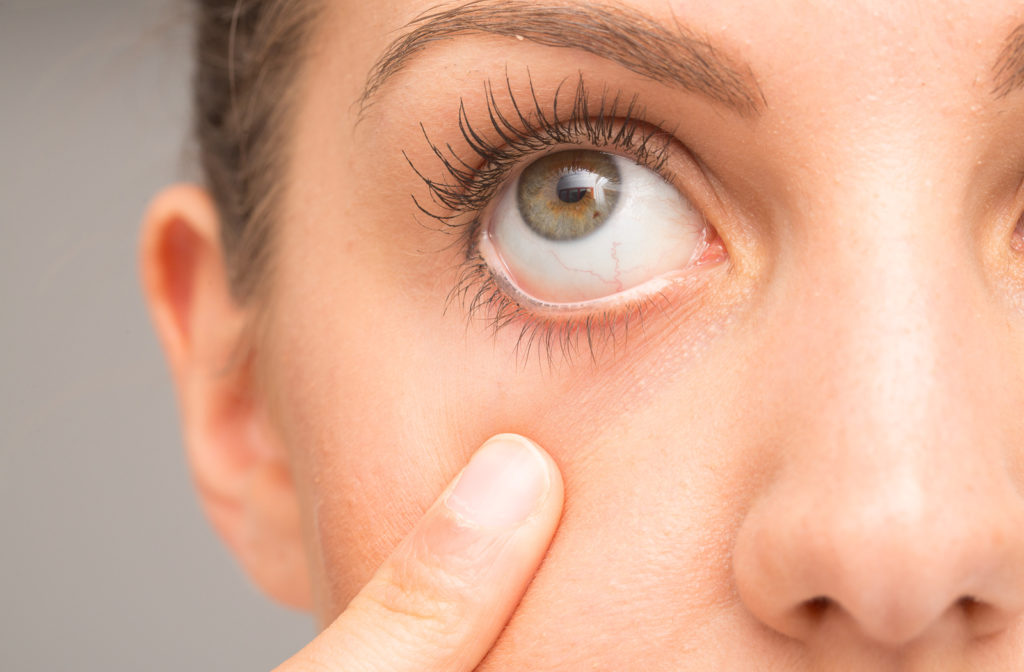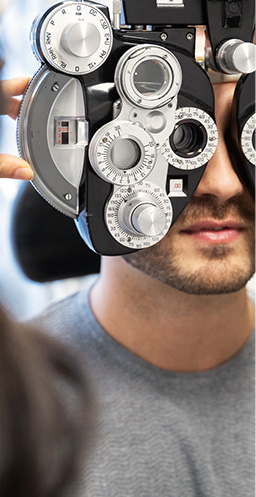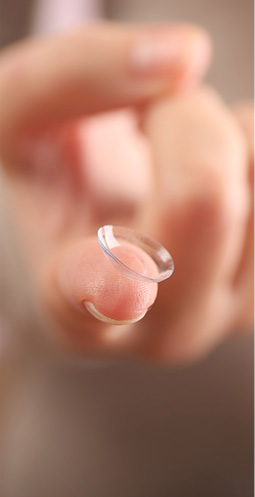
Chronic Dry Eye, What Is It?
Dry eye is a chronic condition that occurs when your eyes do not produce enough tears, or the tears they produce are of poor quality. A lack of good quality tears can cause your eyes to feel dry, irritated, itchy, and even watery.
Dry eye can result due to a myriad of reasons, including ageing, environmental conditions, medication, and hormonal changes. Additionally, dry eye symptoms may be a sign of an underlying health problem.
How is Dry Eye Diagnosed & Treated?
If you are experiencing prolonged symptoms of dry eye, visit your optometrist for a comprehensive eye exam. Your optometrist will perform a series of tests to ensure your symptoms are consistent with chronic dry eye.
Dry eye therapy can consist of various treatments including, premium preservative-free eye drops, eyelid warming masks, eyelid hygiene products. Your optometrist might also recommend in-office treatments such as BlephEx and Mibo ThermoFlo. Additionally, there are specific vitamins and nutrients you can add to your diet to improve your overall ocular health. These include the macular protective pigments lutein, zeaxanthin, and meso-zeaxanthin for age-related macular degeneration and Omega-3 supplements for dry eye disease.
All About Omega-3 Fatty Acids
Essential fatty acids are fatty acids that cannot be produced by the body and therefore need to come from our diet. These include Omega-3 fatty acids and Omega-6 fatty acids.
Omega-3 fatty acids are healthy fats primarily found in certain fish, nuts, and seeds. They are known to have significant anti-inflammatory effects in the body. Omega-6 fatty acids are found in eggs, fried foods, processed foods and most vegetable oils.
Both Omega-3 and Omega-6 fatty acids are essential for good health. That said, an excess of Omega-6 fatty acids in our diet can have a pro-inflammatory response in the body, so it’s important to consume the proper amount. Omega-3’s affect the function of cell receptors in the cell membranes of the body, helping to regulate blood clotting and inflammation. Additionally, omega-3’s bind to receptors to regulate genetic function, which can help to play protective roles in certain conditions, such as:
Omega-3 fatty acids are considered polyunsaturated fats, and there are 3 primary omega-3’s most commonly found in Western diets:
Eicosapentaenoic acid (EPA) and docosahexaenoic acid (DHA) are most commonly found in fish. Alpha-linolenic acid (ALA) is often found in vegetable oil, nuts, flaxseed, and leafy vegetables.
Omega-3’s and Eye Health
Although omega-3 fatty acids have been considered beneficial for many different conditions, they can also be helpful to your ocular health. A study published in Investigative Ophthalmology & Visual Science found that DHA prevented age-related vision loss in lab mice.
Additionally, a study performed by the Brigham and Women’s Hospital found that of the participants involved in the trial, those that consumed the most omega-3 fatty acids had a 17% lower risk of suffering from dry eyes compared to those that consumed little to none.
A diet rich in DHA can help to preserve vision and relieve dry eye, however consuming sufficient amounts of omega-3 fatty acid through food may be difficult due to the volume of food needed to achieve the optimal concentration in our body. Omega-3 supplements can be beneficial in providing the necessary amount to relieve symptoms of dry eye and slow the progression of certain eye conditions.
Omega-3 and Dry Eye
The typical Western diet tends to have a much higher amount of Omega-6 compared to Omega-3. The imbalance in our Omega-3 to Omega-6 ratio can be a contributing factor in the inflammatory response that plays a key role in chronic dry eye.
A common-sense approach is to try and increase our intake of Omega-3 while trying to reduce our intake of Omega-6 to try and restore the proper balance for optimal health.
The Omega-3 fatty acids EPA and DHA have the most potent health benefits and are the most important in controlling the inflammation related to dry eyes. Specifically, a high EPA to DHA ratio may be most beneficial for dry eyes.
Omega-3 from Food vs Supplements
In North America, children and teens only consume 40mg of EPA and DHA per day on average. Adults only consume 90mg of EPA and DHA daily on average.
It’s theoretically possible to get enough Omega-3 from our diet to have a beneficial effect for dry eye, although this is quite difficult to do. For example, in order to get a daily dose of 1,000 mg of EPA and DHA combined, you would need to consume the equivalent of 5 servings of salmon or 27 servings of tuna or 35 servings of haddock per week!
It’s also worth noting that the level of mercury and other toxins accumulating in the body from consuming this much fish would be quite high, and therefore not the best choice. Green leafy vegetables, seaweed, and some nuts and seeds including flaxseed, are also a source of omega-3, although they are primarily a source of ALA (alpha-linolenic acid). ALA has a low conversion (less than 5%) to EPA and DHA and therefore a minimal benefit for dry eye syndrome.
Choosing the Right Supplement
When it comes to sourcing a supplement to boost your intake of omega-3 fatty acids, there are a few things to consider. Some forms of fatty acid are more easily absorbed than others, so knowing the difference can make a difference in the benefit for your overall health and your dry eye syndrome.
In whole fish, omega-3 fatty acids are found as free fatty acids, phospholipids, and triglycerides. In fish oils, which can be found as supplements, omega-3’s are mostly present as triglycerides. In processed fish oils, the refining process causes the triglycerides to convert to ethyl esters, allowing food chemists to adjust the concentrations of DHA and EPA.
Some studies have shown that the absorption of omega-3’s in ethyl ester form is not as efficient as in the triglyceride form.
So, Which Supplements are Best?
Although there are a ton of fish oil supplements available, some are absorbed by your body much more efficiently and have a more beneficial effect. Omega-3 in the triglyceride form is the preferred choice for dry eye.
Not all omega-3 fish oil supplements are created equal. Manufacturing high-quality omega-3 starts with fish caught from the ocean (the fish oil starts out in the triglyceride form). Next, the oil is extracted from the fish, which yields unpurified native oil that still contains toxins. The next step is to remove the toxins with heat and alcohol. This results in the alcohol (ethyl ester) based synthetic form, which is not absorbed well in the body.
Most commercially available omega-3 products are sold in this unpurified, ethyl ester form. What separates high-quality omega-3 supplements is the last step, which involves the removal of the alcohol (a process known as re-esterification) which brings it back to the triglyceride or natural form of the omega-3 but with a higher concentration of EPA and DHA.
The process is time-consuming and costly, but it’s the purest, most potent form of omega-3 that is easily absorbed by the body while being safe and free from toxins. If you’ve noticed cost differences between the various omega-3 supplements on the market, this is the main reason why.
When shopping for your supplement, always be sure to read the label carefully, and check for the following:
- Type of omega 3. Look for a supplement that contains EPA and DHA, specifically a high EPA to DHA ratio of 4:1, which is optimal for dry eye.
- Amount of omega-3. Check the label for the amount of EPA and DHA in each capsule. An alternate form to look for is a liquid form. Most liquid omega-3 supplements will be in the triglyceride form. A teaspoon of high-quality liquid omega-3 typically yields 1200 mg of EPA and 300 mg of DHA. This is equivalent to 4 gel capsules. For most people, this is generally a good start for a daily dose for dry eye syndrome.
- Form of omega-3. Seek out the TG (triglycerides) form of omega-3 over the ethyl esters.
Once you’ve found a supplement you are satisfied with, check the expiry date and smell the capsules or liquid to ensure they haven’t gone bad. Expired or rancid fish oil is less potent and can even be harmful.
If you have any questions about omega-3’s and your eye health, please contact your optometrist for a professional opinion. Additionally, make sure you schedule regular eye exams to pinpoint early signs of disease before they progress.








